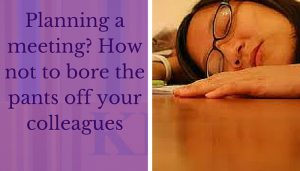It’s a given that calling a meeting is usually a prompt for a collective eye roll and entire teams mentally writing off a whole morning. Meetings don’t have to be a waste of time if they’re run properly (not convinced? Then you obviously haven’t read this).
So how do you have a good meeting? Read on…
Why are you meeting?
Never call a meeting simply to provide a ‘general update’. You’d be much better off putting it in a newsletter that people could read when they have time. If there is something important that you need to communicate, or if input is needed to allow you to make a decision, then you should meet. This is particularly true if the discussions are potentially sensitive, for example in a change management situation where you want to avoid office gossip spreading before you’ve been able to tell people exactly what’s going on.
Who needs to be there?
Don’t drag an entire department into a meeting if you only need to speak to a few key people. Invite those with particular knowledge or skill sets if you need to obtain information. If you’re instigating change only have those who’ll be affected and anyone they can call on for information or advice.
Set a clear agenda
Distribute a written agenda detailing all of the points you’ll need to cover and giving an allotted time for each item. It helps attendees to focus and prevents the meeting being hijacked by someone raising an irrelevant issue under ‘any other business’. There’s always the risk that discussion will meander off down a side street; if you’re running the meeting it’ll be down to you to bring it back on track.
Start and end on time
How many times have you been in a meeting where half the attendees are late but they’re allowed ‘a few more minutes’ to turn up? I know there will always be urgent phone calls or people stuck in traffic, but it’s really annoying when you turn up on time and your colleagues are strolling back from lunch and wandering into the meeting clutching a half chewed sandwich.
If the meeting runs far beyond the allotted finish time you’ll be faced with the dispiriting sight of your colleagues slumping in their seats and surreptitiously glancing at their watches because they’re bored and have a hundred other things to do. All the life has been sucked out of your meeting and the possibility of achieving anything has pretty much vanished.
Have great documents
I’ve lost count of the number of meetings I’ve been in where everyone has spent the first 10 minutes in silence reading background notes. If there is information that attendees need to have before the meeting starts, send it out in advance. That way you can start discussions straight away.
If you’re in a change management situation you’ll need to control the flow of information to avoid rumour spreading. You’ll probably find that no-one will absorb all of the information during the initial meeting so some follow up documents will be needed giving a summary of the matters discussed as well as any additional background detail.
Ban technology
Don’t let anyone take their phone in – they’re just distracting.
Follow up properly
Send out a summary of the meeting confirming what decisions were made, any follow up action and who is responsible for it. Format is key; short paragraphs are much more likely to be read than lengthy minutes.
Do you follow these rules? If you have any of your own, I’d love to hear them.
If you want to try a new approach to your internal document production or content marketing, Get in touch or register here to receive regular updates, special offers and a free copy of my guide, ’10 Tips to create copy that converts’.
